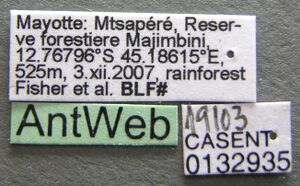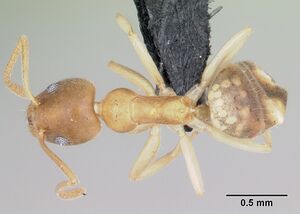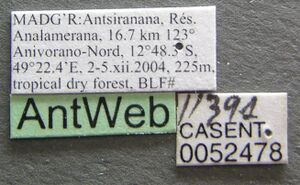Technomyrmex innocens
| Technomyrmex innocens | |
|---|---|

| |
| Scientific classification | |
| Kingdom: | Animalia |
| Phylum: | Arthropoda |
| Class: | Insecta |
| Order: | Hymenoptera |
| Family: | Formicidae |
| Subfamily: | Dolichoderinae |
| Genus: | Technomyrmex |
| Species: | T. innocens |
| Binomial name | |
| Technomyrmex innocens Fisher & Bolton, 2007 | |
Most of the material examined was obtained by beating low vegetation but some was collected from litter, some from rotten wood and some from rotten sticks on the forest floor. Worker-queen intercastes are known, as are alate queens. (Bolton 2007)
Identification
Bolton (2007) - A member of the T. pallipes complex in the Technomyrmex albipes group. There are three small, yellow to light brownish yellow Malagasy Technomyrmex species that have setae present on the dorsal head behind the level of the posterior margin of the eye. Of these Technomyrmex madecassus is overall the most densely setose and has very distinct setal pits. It also has the metathoracic spiracles abutting, or very close to, the metanotal groove in dorsal view, has 2 - 4 pairs of mesonotal setae and has 2 - 3 pairs of setae present on the lateral margins of the propodeal declivity. Even in abraded specimens tne pits of these setae remain very conspicuous. In contrast innocens has much less distinct setal pits, has the metathoracic spiracles relatively widely separated from the metanotal groove in dorsal view and has only a single, very short pair of mesonotal setae; like madecassus it has setae present (a single short pair) on the propodeal declivity. Like innocens, Technomyrmex fisheri has its metathoracic spiracles some distance from the metanotat groove, but fisheri is characterised by its lack of setae (and setal pits) on the mesonotum and propodeal declivity.
Keys including this Species
Distribution
Latitudinal Distribution Pattern
Latitudinal Range: -16.36666667° to -19.006727°.
| North Temperate |
North Subtropical |
Tropical | South Subtropical |
South Temperate |
- Source: AntMaps
Distribution based on Regional Taxon Lists
Malagasy Region: Madagascar (type locality), Mayotte.
Distribution based on AntMaps
Distribution based on AntWeb specimens
Check data from AntWeb
Countries Occupied
| Number of countries occupied by this species based on AntWiki Regional Taxon Lists. In general, fewer countries occupied indicates a narrower range, while more countries indicates a more widespread species. |

|
Estimated Abundance
| Relative abundance based on number of AntMaps records per species (this species within the purple bar). Fewer records (to the left) indicates a less abundant/encountered species while more records (to the right) indicates more abundant/encountered species. |

|
Biology
Castes
Worker
Images from AntWeb
   
| |
| Worker. Specimen code casent0132935. Photographer Erin Prado, uploaded by California Academy of Sciences. | Owned by CAS, San Francisco, CA, USA. |
   
| |
| Queen (alate/dealate). Specimen code casent0435441. Photographer April Nobile, uploaded by California Academy of Sciences. | Owned by CAS, San Francisco, CA, USA. |
   
| |
| Holotype of Technomyrmex innocens. Worker. Specimen code casent0485542. Photographer April Nobile, uploaded by California Academy of Sciences. | Owned by CAS, San Francisco, CA, USA. |
Male
Images from AntWeb
     
| |
| Male (alate). Specimen code casent0052478. Photographer April Nobile, uploaded by California Academy of Sciences. | Owned by CAS, San Francisco, CA, USA. |
Nomenclature
The following information is derived from Barry Bolton's Online Catalogue of the Ants of the World.
- innocens. Technomyrmex innocens Fisher & Bolton, in Bolton, 2007a: 52, fig. 27 (w. w-q intercaste) MADAGASCAR.
Unless otherwise noted the text for the remainder of this section is reported from the publication that includes the original description.
Description
Worker
Holotype. TL 2.8, HL 0.65, HW 0.60, SL 0.62, PW 0.40, WL 0.86. Indices: CI 92, SI 103, OI 25, EP1 63, DTI 137.
Frontal carina with 2 setae: in profile the posterior of these located at about the level of the anterior margin of the eye and the longest on the dorsum. Dorsum of head posterior to this with a pair of shorter setae at about the level of the posterior margin of the eye and with three pairs posterior to this; the longest of these three pairs about two-thirds the distance to the posterior margin of the head and the posteriormost pair just in front of the posterior margin (cephalic setae are somewhat variable, see comments below). Setal pits visible as darker pinpoints on paler cuticle. Anterior clypeal margin with a small, shallow median impression. With head in full-face view the sides shallowly convex and the posterior margin with a shallow median concavity. Eyes located well in front of midlength, EPI 63; outer margin of eye almost touches the outline of the side in full-face view. Number of setal pairs on mesosoma: pronotum 2; mesonotum 1, very short and located on the posterior one-third; propodeal dorsum 0; lateral margins of propodeal declivity 1, very short and located above the spiracle. In dorsal view the metathoracic spiracles are widely separated from the metanotal groove, not abutting it (distance separating them is at least equal to the diameter of the metathoracic spiracle). Dorsum of mesonotum evenly curved in profile. Dorsum of propodeum meets the declivity in a blunt angle; length of dorsum less than depth of declivity to spiracle. Gastral tergites 1 - 4 each with setae distributed everywhere on the sclerites; maximum length of setae on first gastral tergite is distinctly less than the maximum diameter of the eye. Head, mesosoma, petiole and gaster yellow, dorsum of head and gaster weakly brownish yellow; legs yellow throughout.
Other worker. TL 2.3 - 3.1, HL 0.55 - 0.71, HW 0.51 - 0.64, SL 0.52 0.64, PW 0.32 - 0.43, WL 0.68 0.95 (15 measured). Indices: CI 88 - 94, SI 96 - 110, 01 25 - 28, EPI 60 - 70, DT1 133 143.
Setae on head behind clypeus somewhat variable in number and position. Two, three (the usual number) or four pairs may be present on the dorsum behind the level of the posterior margin of the eye. Where only two pairs are present behind the level of the posterior margin of the eye there is a short pair above the eye; apparently this and the following pair of setae have shifted slightly anteriorly from the position seen in the holotype, as both have the same number of setae present. Where four pairs are present there is an additional pair behind the level of the posterior margin of the eye. The pronotum may have 3 pairs of setae. Where setae have been abraded off small pits, that are darker in colour than the surrounding cuticle, are usually visible. Colour varies from yellow to light brown throughout.
Type Material
Holotype worker, Madagascar: Provo Mahajanga, P.N. Namoroka, 17.8 km. 3290 WNW Vilanandro, 100 m., 16°22.6'S, 45°16.6'E, 8-12.xi.2002, CASENT 0485542, BLF 6510(11), beating low vegetation, tropical dry forest (Fisher et at.) (California Academy of Sciences).
Paratypes. 3 workers with same data as holotype but CASENT 0022497, BLF 6506(17), sifted litter; CASENT 0022500, BLF 6506(19); CASENT 0485538, BLF 6510(9). 2 workers + 1 intercaste, same locality but 9.8 km. 3000 WNW Vilanandro, 140 m., 16°28.0'S, 45°21.0'E, 4-8.xi.2002, CA5ENT 0474760 and CASENT 0474761, BLF 6448(13) (Fisher et al.) (CASC).
References
- Bolton, B. 2007. Taxonomy of the dolichoderine ant genus Technomyrmex Mayr (Hymenoptera: Formicidae) based on the worker caste. Contributions of the American Entomological Institute. 35(1):1-149.
- Cantone S. 2018. Winged Ants, The queen. Dichotomous key to genera of winged female ants in the World. The Wings of Ants: morphological and systematic relationships (self-published).
References based on Global Ant Biodiversity Informatics
- Blaimer B. B., S. G. Brady, T. R. Schultz, and B. L. Fisher. 2015. Fucntional and phylogenetic approaches reveal the evolution of diversity in a hyper diverse biota. Ecography 38: 001-012.
- Bolton B. 2007. Taxonomy of the dolichoderine ant genus Technomyrmex Mayr (Hymenoptera: Formicidae) based on the worker caste. Contributions of the American Entomological Institute 35(1): 1-150.
- Bolton, B. "Taxonomy of the dolichoderine ant genus Technomyrmex Mayr (Hymenoptera: Formicidae) based on the worker caste." Contributions of the American Entomological Institute 35, no. 1 (2007): 1-149.

